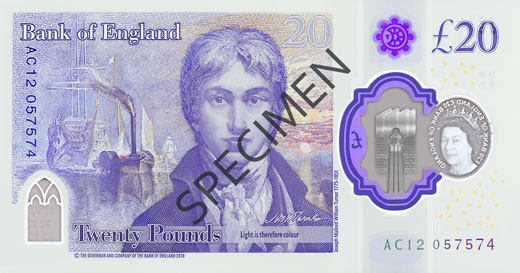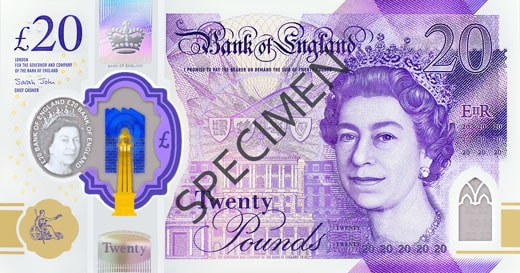What should retailers know about the new £20 note?
The new £20 note came into effect on 20th February 2020. It is said to be ‘the most secure ever’ banknote, which is good news for retailers and the general public as the £20 note is the most common note in circulation.
- Both the new polymer and paper notes should continue to be accepted until the paper note’s withdrawal date, 30 September 2022
- Paper notes will gradually be taken out of circulation as they are banked by the public and retailers
- Staff should be trained on how to spot the differences between real and counterfeit notes
- Staff should know what to do if they suspect a note is counterfeit
- Always check a few of the security features, not just one
- The Bank of England website has information and free downloadable education materials about the banknotes
- Engage with banknote machine suppliers to ensure note accepting or dispensing machines will be updated
- Join the Banknote Checking Scheme
Image source: The Bank of England
What are the features of a polymer banknote?
- Stronger notes lasting 2½ x longer than paper notes
- More environmentally friendly – carbon footprint is 16% lower than paper and can be recycled
- Cleaner notes – resistant to dirt and moisture
- Can withstand extreme temperatures
- First used in September 2016 for £5 note and the £10 note was introduced 12 months later
In a nutshell, notes made from polymer are more durable, hygienic and secure.
What are the security features of the new £20 note?
The new £20 note has the following security features, making it more difficult to forge.
- Hologram – the words change between ‘Twenty’ and ‘Pounds’ when tilted
- See-through window – metallic image over the main window; the foil is blue and gold on the note and silver on the back
- Queen’s portrait in the see-through window
- Silver foil patch contains the letter ‘T’
- Raised print on the front of the note
- Sharp and clear printed lines and colours
- Ultra-violet number – ‘20’ appears in bright red and green on the front
How do I check whether the new £20 note is counterfeit?
- Consider using or purchasing a good UV light that emits around 365 nanometres. This will detect a vivid number within the polymer note.
- Detector pens will no longer be suitable to detect counterfeits because the pens are designed to react with starch within the old style of note. As the new notes are made from plastic it won’t have the same reaction.
- Be aware that high value counterfeit notes are often used to buy a low-value item
- If you do suspect that you have a counterfeit note, take it to the nearest police station, where you will receive a receipt and an incident number
When does the old paper £20 note go out of circulation?
The old paper £20 note goes out of circulation on 30 September 2022. Old paper £50 notes will also be withdrawn from circulation on the same day.
As with other notes and coins that have gone out of circulation, many banks will still accept them from their customers. The Post Office may accept the old paper £20 note as a deposit into any bank account accessible at the Post Office. Withdrawn notes can always be exchanged with the Bank of England.
Banknotes don’t just hold economic value; there is a cultural value as well
Banknotes have been in existence for 300+ years and during that time the way that the notes have been printed has changed a lot. Since the mid-1980s, there have been four denominations in circulation, £5, £10, £20 and £50. It is vital that banknotes are of high quality, long lasting and difficult to forge and the latest development of printing notes on polymer fulfils all of these 3 requisites.
The governor of the Bank of England, Mark Carney, alluded to the fact that banknotes are much more than a practical necessity: “They can be a piece of art in everyone’s pocket. Banknotes are a celebration of the UK’s heritage, a salute to its culture, a testament to its great achievements, including those of its notable citizens.”
Who is the face on the new £20 note?
As with all British banknotes, there is an image on the back of the note and this time it is JMW Turner. This was actually announced on 22nd April 2016 with the great British painter to replace the old face of the paper £20 note, Adam Smith, the economist. Turner will become the first artist to appear on a British banknote following a nationwide vote.
Who is JMW Turner?
Joseph Mallord William Turner (1775 – 1851) was famous for his landscape and seascape paintings and is often referred to as being ahead of his time and the first modern artist, because of his messy and expressive style and use of bright colours, the latter making him known as ‘the painter of light’.
The note features a self-portrait of the artist JMW Turner painted c1799 and which can be seen at Tate Britain where much of Turner’s work is on display. The backdrop is The Fighting Temeraire, one of Turner’s most famous paintings, a tribute to HMS Temeraire, which was prominent in Nelson’s victory at The Battle of Trafalgar. There is also an image of the Turner Contemporary gallery and of Margate Lighthouse. It also has a quote, “Light is therefore colour”, a reference to Turner’s innovative use of light, shade, tone and colour with his signature taken from his will.

Image source: The National Gallery
Are there any plans to change the £50 note?
The mathematician Alan Turing is the face of the new polymer £50 note which entered general circulation on 23 June 2021. The last day the old paper £50 note can be used is on 30 September 2022.





